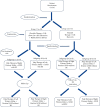The Effect of Breathing Exercise Using Bubble Blower on Anxiety and Pain during Inferior Alveolar Nerve Block in Children Aged 7 to 10 Years: A Crossover Randomized Clinical Trial
- PMID: 35082960
- PMCID: PMC8786543
- DOI: 10.1155/2022/7817267
The Effect of Breathing Exercise Using Bubble Blower on Anxiety and Pain during Inferior Alveolar Nerve Block in Children Aged 7 to 10 Years: A Crossover Randomized Clinical Trial
Abstract
Introduction: The aim of this study was to evaluate the effect of breathing exercise using bubble blower on anxiety and pain during inferior alveolar nerve block (IANB) in children aged 7 to 10 years.
Materials and methods: In this randomized crossover clinical trial, thirty-five children with moderate to severe anxiety requiring bilateral pulp therapy of mandibular primary molars were enrolled. Based on random lists, 18 children received the BE + IANB and 17 children received a routine IANB at the first session. This trend became reverse at the second visit for each child. Anxiety was measured using Facial Image Scale (FIS), blood pressure, and pulse rate. Face Leg Activity Cry Consolability (FLACC) scale and Wong-Baker Facial Pain Scale (WBFPS) were used for pain measurement. The Paired Samples Test, Wilcoxon Signed Rank Test, and Interclass Correlation Coefficient were used for data analysis.
Results: The means of FLACC, WBFPS, FIS, blood pressure, and pulse rate were higher at the control visit. However, these differences were statistically significant only for FLACC scale and WBFPS (P value <0.05). In subgroup analysis, only girls and children without any previous dental treatment showed significant differences in FLACC scale and WBFPS between the control and bubble blower side (P value <0.05).
Conclusion: Breathing exercise using a bubble blower may be an efficient distraction and relaxation method to decrease pain of 7- to 10-year-old children with moderate to severe anxiety during inferior alveolar nerve block. However, anxiety levels were lower when applying BE, and the differences were not statistically significant.
Copyright © 2022 Zahra Bahrololoomi et al.
Conflict of interest statement
The authors declare that they have no conflicts of interest.
References
Publication types
MeSH terms
Substances
Associated data
LinkOut - more resources
Full Text Sources
Medical


